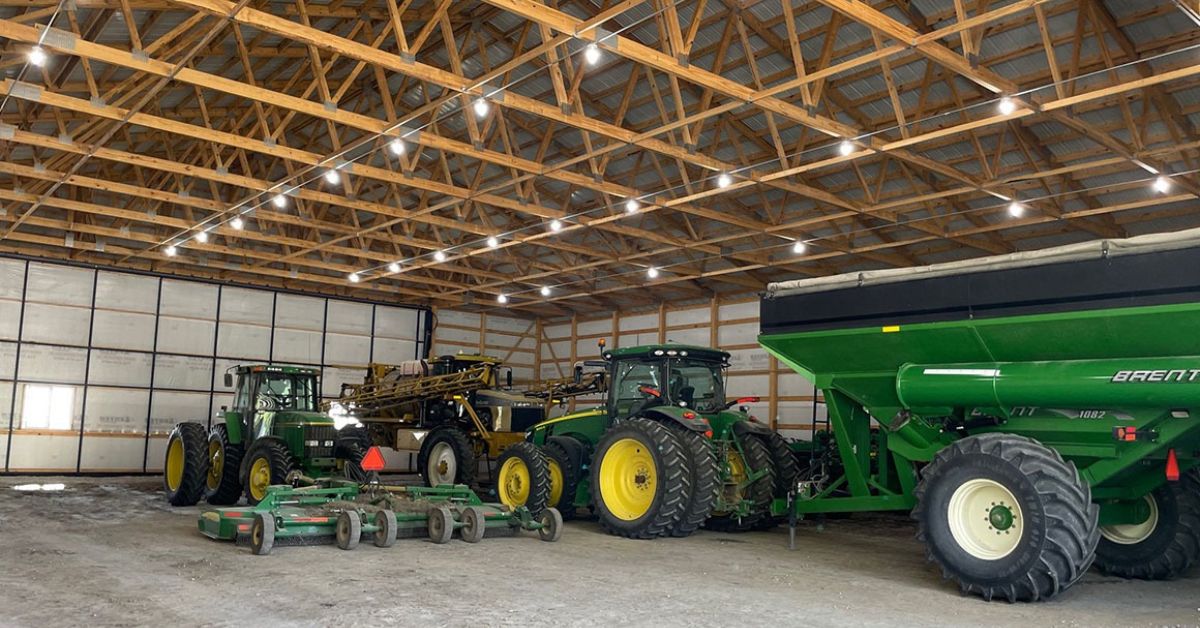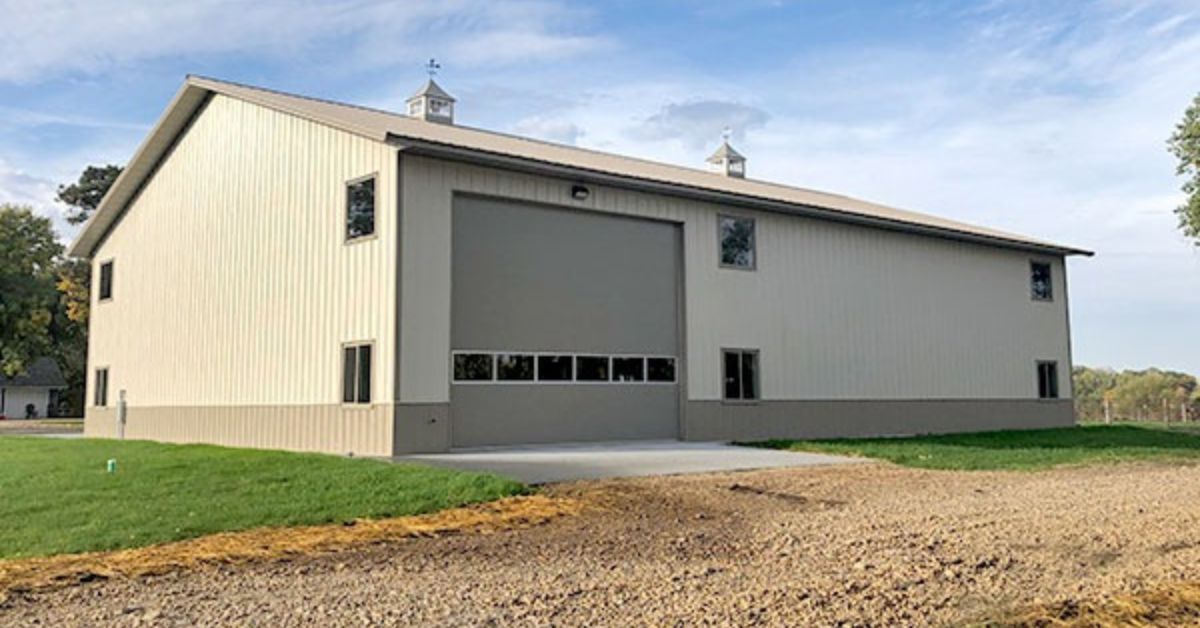Security Considerations for Farm Equipment Storage Buildings

Farm equipment represents one of the largest investments for agricultural operations, with modern tractors, combines, and implements often costing hundreds of thousands of dollars. Unfortunately, this valuable machinery has become an increasingly attractive target for thieves, making security a critical concern for farmers across the country.
Unlike other types of theft, stolen farm equipment is often difficult to recover due to its mobility and the ease with which identification numbers can be altered or removed. This reality makes prevention essential. Below, we’ll discuss the most important security considerations you should make for farm equipment storage buildings, including key insights to prevent theft.
Types of Farm Equipment Storage and Their Uses
Before diving into security considerations, let’s cover the various storage options so you can determine which is most appropriate for your operation:
- Enclosed buildings: These structures include pole barns, steel buildings, and traditional barns. They offer concealment and multiple points for security systems.
- Open sheds and lean-tos: Their open design presents unique security challenges as equipment remains visible and accessible.
- Outdoor storage: While the least secure option, proper planning can still provide meaningful protection through strategic placement and security measures.
Implementing unique security measures for each type of structure makes it easier to secure your property.
1. Perimeter Security
Fencing serves as both a physical and psychological barrier. While chain-link fencing provides visibility for surveillance, privacy fencing conceals equipment from casual observation. Consider barbed wire or razor wire additions for enhanced deterrent value, though local regulations may restrict these options.
Lighting transforms your property’s security profile dramatically. Motion-activated LED lights provide cost-effective illumination while conserving energy. Solar-powered options work well for remote locations without electrical infrastructure. Strategic lighting eliminates hiding spots and makes nighttime surveillance more effective.
2. Building Security
Doors should be constructed from heavy-duty materials with reinforced frames. Overhead doors, common in equipment storage, need special attention as they’re often seen as weak points. Consider adding additional locking mechanisms beyond standard hardware, such as slide bolts or padlock hasps.
Windows, while providing natural light and ventilation, can become security vulnerabilities. Security film makes glass harder to break quietly, while bars or shutters provide physical barriers. For new construction, consider eliminating unnecessary windows in favor of skylights or high-mounted windows.
3. Alarm Systems and Monitoring
Motion sensors detect movement within buildings, triggering alarms when armed. Pet-immune sensors prevent false alarms from small animals while maintaining sensitivity to human-sized intruders. Wireless sensors simplify installation in existing buildings.
Door and window sensors create perimeter monitoring for buildings. For example, magnetic sensors detect opening doors or windows, while vibration sensors can detect attempts to force entry. These systems work best as part of comprehensive alarm packages.
4. Surveillance Systems
Recording systems have evolved from tape-based systems to digital storage solutions. Cloud-based storage provides off-site backup protection, while local storage maintains control over your data. Consider systems with remote viewing capabilities through smartphone apps.
Camera placement requires strategic thinking about coverage areas and blind spots. Focus on entry points, high-value equipment areas, and perimeter zones. Ensure cameras are positioned high enough to prevent tampering while maintaining clear views of faces and license plates.

5. Key Management and Access Control
Key control starts with limiting physical keys to essential personnel only. Avoid hiding spare keys in obvious locations such as magnetic boxes under equipment or above door frames. Consider keyed-alike systems for convenience without compromising security.
Electronic access systems provide superior control over traditional keys. Programmable codes can be changed easily when personnel changes occur. Some systems provide audit trails showing when entries occurred and which codes were used.
6. Regular Security Audits and Inspections
Vulnerability assessments help identify security gaps before criminals exploit them. Walk your property from an intruder’s perspective, looking for weaknesses in your current security measures.
Monthly inspections should cover all physical security elements, from fence integrity to lock functionality. Create checklists to ensure you don’t overlook anything. Document any issues you discover, and address them promptly.
7. Insurance Coverage for Farm Equipment
While it doesn’t prevent theft, proper insurance coverage provides financial protection when security measures fail. Evaluate coverage annually as equipment values and security measures change.
Ensure policy limits reflect current equipment values, including appreciation for vintage or specialized machinery. Some policies offer rental equipment coverage while claims are processed, maintaining operational capacity during critical periods.
8. Cybersecurity for Smart Farming Technology
Modern farm equipment increasingly relies on digital systems, creating new security vulnerabilities that require attention. Change default passwords on all connected devices, use strong authentication, and keep software updated.
Use proper data protection to prevent unauthorized access to operational data stored in equipment systems. Establish procedures for monitoring and installing updates, balancing security needs with operational requirements.
9. Emergency Response Plan
When security breaches occur, a rapid and organized response can minimize losses and aid in recovery efforts. Detection procedures should clearly define how to identify and report security incidents. Ensure all personnel know whom to contact and what information to gather when incidents occur.
Recovery planning addresses post-incident needs such as temporary equipment, insurance claims, and operational continuity. Clear plans reduce the stress and confusion that follow security breaches.

10. Community Watch Programs and Local Law Enforcement
Information sharing about suspicious activity helps prevent crimes across the community. Many areas have established communication networks through social media or messaging apps for real-time information sharing.
Establish networks with neighbors to create extended surveillance through mutual cooperation. Sharing contact information with nearby farms enables rapid notification of suspicious activity. Many rural communities have even established formal watch programs.
The Benefits of Outsourcing Farm Building Construction
When planning new storage facilities, partnering with professional construction companies brings significant advantages to your security planning process. Professional builders understand agricultural security requirements and can incorporate security features during initial construction rather than retrofitting later. This approach often proves more cost-effective while providing superior results.
Experienced contractors can recommend security-focused design elements, such as reinforced doors, strategic window placement, and electrical infrastructure supporting comprehensive security systems. They also understand local building codes and zoning requirements that might affect security installations. Professional construction also typically includes warranties and ongoing support, providing peace of mind for your investment.
Protecting Your Equipment Starts Now
No single security measure provides complete protection for farm equipment storage buildings. Layered defenses create significant obstacles for potential thieves while providing multiple opportunities for detection and response. Start with basic physical security measures such as quality locks and lighting, then add electronic systems as budget permits. Remember that security is an ongoing process requiring regular attention and updates.
If you’re ready to take action, Lester Buildings offers significant value for your money. With our farm equipment storage buildings, security is always a priority. Invest today, and protect your farming operation’s future success!
